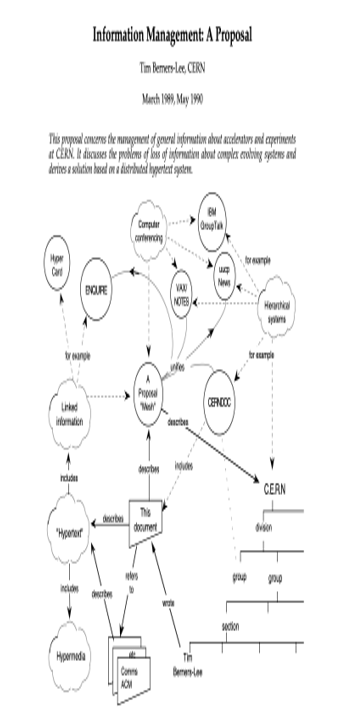Birth of the World Wide Web – Transport Layer Security at a Glance
6.1 Birth of the World Wide Web
Conseil Européen pour la Recherche Nucléaire, the European Organization for Nuclear Research, better known by its acronym CERN, is a European research organization operating the world’s largest particle physics laboratory as well as the Large Hadron Collider, the world’s largest high-energy particle collider [184]. CERN, which is located in Geneva, Switzerland, also hosts a large computing facility for storing and analyzing data collected in experiments.

Figure 6.1: Project proposed at CERN by Tim Berners-Lee that led to the creation of the WWW
In 1989, while working as an independent contractor at CERN, the British computer scientist Tim Berners-Lee invented the WWW [44]. Berners-Lee wrote a project proposal describing how information about accelerators and experiments at CERN can be managed using a distributed hypertext system [20].
The report described what CERN needed from such a system and how it could be used to create and share information among CERN researchers.
From the beginning, the WWW was designed for easy access to information, with the early web pages containing links to information useful for scientists working at CERN. To achieve this, a way to link and access heterogeneous information as a web of nodes that the user can browse at will was needed. Berners-Lee, together with his CERN colleague Robert Cailliau, created a new protocol called HyperText Transfer Protocol (HTTP) to standardize communication between servers and clients [40].
To consume, add, and edit information in the WWW, Berners-Lee introduced a browser, a program that provided access to hypertext documents [21]. It had many features of today’s web browsers and, in addition, offered functionality to modify WWW pages directly within the browser [44].
The original browser created by Berners-Lee ran on the NeXT computer platform, which only a few users could afford at that time. To overcome this limitation, a line-mode browser was developed at CERN that could run on any system [44].
In 1991, Berners-Lee released the WWW software, including the line-mode browser, the web server software, and a library for developers. The software was announced on internet newsgroups in August 1991 and quickly spread around the world. In December 1991, the first web server went online in the US, at the Stanford Linear Accelerator Center (SLAC) in California [44].

